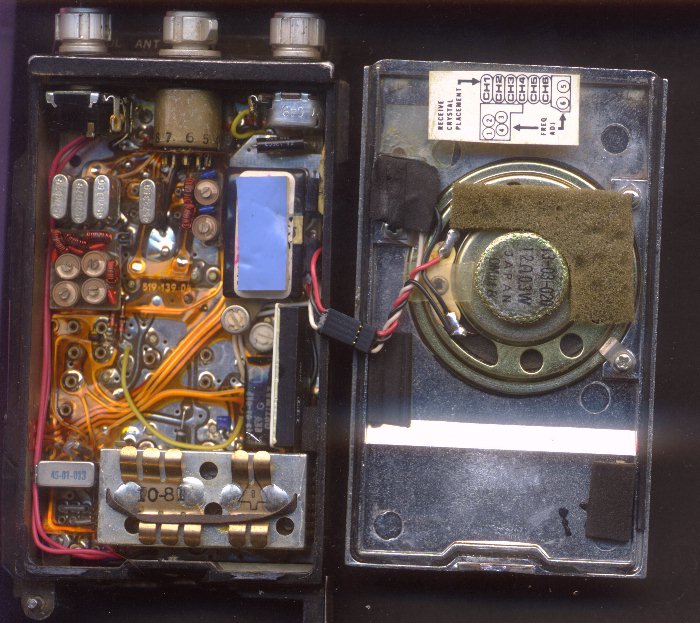A Local Frequency Standard – For South AfricaA "Local"Frequency Standard
Howdo you know if you are transmitting on the right frequency? How doyou know when to start the bulletin? How do you correct the deviationon your rig to the new(ish) 12.5kHz channel standard?
Fora great many years we would tune into WWV or ZUO and "Zero-beat"the "standard" 5.0MHz or 2.5MHz against an uncalibratedoscillator. This method would be good to a few Hertz and wouldusually hold for a few days on H.F. On VHF and UHF the calibrationwould be several tens of Hertz out due to frequency multiplication.Until the advent of crystal controlled digital frequency countersthis was pretty much the only method available to a radio amateur.
Mostmodern counters have a stable and accurate reference source internalto the counter. Most bench type counters have an external connectingsocket to attach a more accurate reference standard. Portable devicesused to allow the user easy adjustment to the internal reference. Buton the unit that Stuart showed me the other day, this was definitelynot an option.
Youhave an extremely accurate "Frequency Standard" transmittedall around you – the SABC TV transmissions. The line scan frequencyis the easiest to use as it is only 15625 Hertz. This can be ‘pickedup’ using a loop of wire placed against the rear of the televisionset. This means that you don’t have to open the television set. (Seethe above section) The frequency is accurate as it originates from arubidium standard used inside the SABC. This "standard"frequency used to be referred to the National Standard Frequencyprovided by the CSIR. I was informed in the 1980’s that thediffererence was of the order of 10^-23 (10 to the power -23). Tomost of us that means that it has an equivalent accuracy.
Dueto the national coverage of the SABC, this will function quitehappily over most of the South Africa. This method however, has theadvantage of being ‘low cost’ and generally available. An alternativeto this method is the use of the clock frequency used internally bythe GPS system. The GPS satellite network may suffer outages due tosun storm activity and availablity of satellites. Not everyone canafford a GPS either.
This’locked’ signal can then be used to ‘pull’ a 1 or 10 Megahertzcrystal oscillator. A simple block diagram is shown below. Thecircuitry can be CMOS as the frequencies involved are not high. Asuitable phase detector is the 4046 chip, which has been used beforefor phase locking radios to a crystal oscillator.
Whilstthe frequency standard used by the SABC TV transmission can be tracedback to the "Standard Frequency" for South Africa.Unfortunately a "Time Standard" cannot. So a clock run bythe "local standard" will never lose or gain time by anyperceptable amount. Unfortunately it will probably never indicate the"correct time"! Remember the old quip about the clocks thatlost a second a day and the other was stopped?
[Fora Wiki definition of ‘time standard’, go to;http://en.wikipedia.org/wiki/Time_standard]
Time Standards inAfrica
Sowhat? You may ask. In Africa the accurate time of day is notrelevant. Well the measurement of time has some vital purposes.Aircraft navigation is one of them. For if you cannot measure how faryou have travelled, you will need to know your speed and last knownposition as well as the elapsed time. Not too difficult when using aGPS system, but if the GPS is out of commission…
Intriguinglyin the UK, the best selling items of a "scientific" natureare the clocks that synchronise to the 60kHz signal transmitted fromAnthorn. It used to be Rugby but was moved more centrally quiterecently. Unfortunately even this is way out of range for SouthAfrica.
Ourlocal stations ZUO and ZSC which supposedly transmit on 2.5MHz,5.0MHz and 4.291MHz as well as 8.461kHz are either not heard orignored for a variety of reasons. Can you remember ever hearing thesestations?
[TheAmericans still run WWV check out the NIST Station WWV.
Goto; http://tf.nist.gov/stations/wwv.html]
Use the Internet
Ofcourse we have the Internet these days. So you can obtain an accuratetime signal from various servers on the net using the Network TimeProtocol. Well you could if your firewall allowed you. With a hugenumber of people connecting in Europe recently, it was possible forthe router manufacturers to set the time in firmware. The router canbe programmed in factory to use NTP to access a "time server"when it connects to the Internet. Only problem there was that thedesigners chose an obscure time server at a university which had aslow and paid-for connection. The massive number of routers all overEurope that enquired the time from the server, took up all thebandwidth. Costing the university a fortune.
[Thereare local as well as overseas "Time Servers". The list isat;
Localtime servers and information; http://www.time.za.net/
RhodesUniversity; http://noticeboard.ru.ac.za/post.5505513]
You can set yourown PC to get NTP time signals.
Ifyou are behind a firewall (which I hope you are if you are using aMicrosoft product), your firewall must allow UDP packets to go out toport 123 and allow UDP packets to return from port 123 to yourmachine. Most proper firewalls (PIX, FreeBSD, Linux Netfilter) willallow this type of behaviour unless specifically denied by youradministrator.
Doesn’tfill you full of confidence, does it?
[Youhave moved the mouse. NT must be restarted for the changes to takeeffect.]
Whatdo you do when you have the "right time" on your PC? How doyou set your clocks to the same time? No automatic synchronisation isavailable yet. So you are left with a clock on screen and goodreaction time, setting buttons or dials…
PersonallyI use ‘ntp.is.co.za’ in the window above to set my PC’s time. Thishas been quite successful in getting all the clocks synchronised.
Computer NetworkTime Synchronisation
"NTPenthusiasts have much in common with radio amateurs (example myself),even if the boss sees little need to wind the clock to thenanosecond."
http://www.eecis.udel.edu/~mills/book.html
Forone amateur’s view of HF Time Standards go to;
http://www.ac6v.com/standard.htm
Andanother, Radio Controlled Clock – Hans Summers;
http://www.hanssummers.com/electronics/clocks/radio/index.htm
ComputerTime Services;
http://www.npl.co.uk/time/research/computer_time_service/
SOUTHAFRICAN QUALIFICATIONS AUTHORITY REGISTERED UNIT STANDARD:
http://fgas.saqa.org.za/showUnitStandard.php?id=244207
MSFEnthusiasts
http://www.npl.co.uk/time/msf/msf_enthusiasts.html
http://www.cl.cam.ac.uk/~mgk25/time/lf-clocks/
GPSUTC and TAI clocks
http://www.leapsecond.com/java/gpsclock.htm
MSFTx
http://www.npl.co.uk/time/msf/
MSFSoftware
http://www.rtrussell.co.uk/products/msf/msf.html
NPL- Bushy House History

